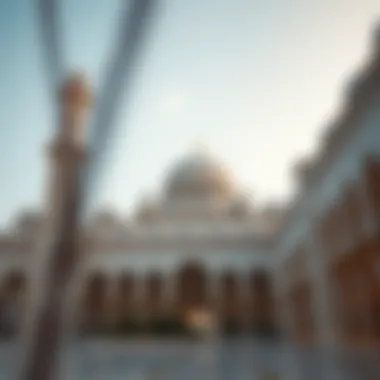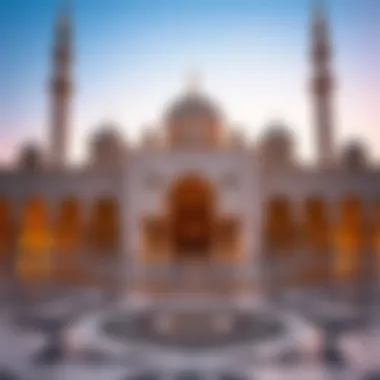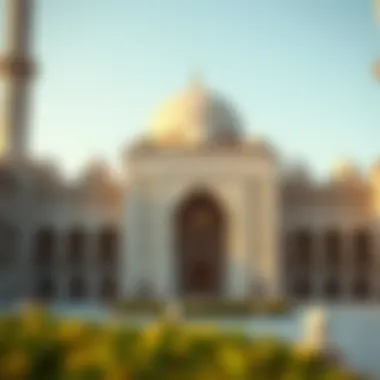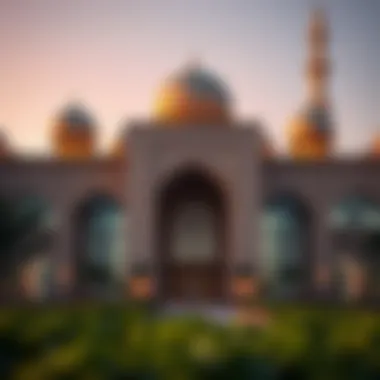Exploring Jumeirah Mosque: A Comprehensive Study


Intro
The Jumeirah Mosque stands as a pivotal landmark in Dubai, representing more than just a site of worship but also serving as a vibrant point of cultural intersection in one of the world’s most multicultural cities. Known for its striking white stone structure and enchanting minarets, this mosque not only showcases Islamic architecture but also opens its doors to tourists and locals alike, fostering a deeper understanding of Islamic traditions.
The mosque's design is a nod to the Fatimid architectural style, which originated in Tunisia over a thousand years ago. This connection to history and heritage enriches the experience for visitors, offering an opportunity to engage with the profound narrative that surrounds Islamic culture in the Emirates. By welcoming non-Muslims, the mosque aims to bridge gaps in cultural perception and promote awareness amidst the diverse populace of Dubai.
In this exploration, we will delve into various aspects of the Jumeirah Mosque, especially how it fits into the broader social context and the implications for property investors. We will uncover current market trends, investment strategies, and the mosque's role as a cultural beacon in Dubai’s evolving landscape. Through this comprehensive study, we aim to equip prospective investors and cultural enthusiasts with knowledge that goes beyond mere aesthetics and touches upon the strategic significance of this profound place.
Prologue to Jumeirah Mosque
The Jumeirah Mosque stands as an iconic representation of Islamic architecture in Dubai and a significant cultural landmark within the United Arab Emirates. It serves not only as a place of worship but also as a symbol of understanding and respect among diverse communities. Its grandeur and accessibility make it a focal point for both tourists and locals, showcasing the harmonious blend of tradition and modernity that characterizes Dubai.
One of the most important aspects of the Jumeirah Mosque is its role in fostering intercultural dialogue. In an age where global connections are more crucial than ever, this mosque acts as a cultural bridge. Visitors often engage in guided tours that not only highlight the architectural beauty of the structure but also offer insights into the values and practices of Islam. This is particularly important for expatriates and non-Muslim audiences who seek to understand and appreciate the nuances of the local culture.
Geographical Context
Set against the backdrop of the bustling city of Dubai, the Jumeirah Mosque is located in the heart of the Jumeirah district. This prime location is just a stone's throw away from the majestic shores of the Arabian Gulf and enjoys easy access to other key attractions. The area itself is characterized by upscale dining, luxury shopping, and a vibrant expat community, merging the old-world charm of Islamic culture with contemporary flair.
From an investors' perspective, the geographical placement of the mosque highlights its potential impact on local property values. Properties in close proximity to culturally significant landmarks often see growth in demand, partly due to their appeal to tourists and residents alike attracted by the cultural richness of the area.
Architectural Overview
The architectural features of the Jumeirah Mosque are worthy of careful examination. Constructed in 1979, it was designed in the traditional Fatimid style of architecture, which is frequently seen in North Africa. The mosque's two soaring minarets and grand central dome serve as a visual anchor for anyone navigating the Jumeirah skyline. The intricate detailing of its stone façade and the geometric patterns that adorn its walls are not just aesthetically pleasing but also carry profound spiritual meanings.
Inside, the mosque offers a serene sanctuary adorned with vibrant Islamic art and mesmerizing calligraphy. Visitors step into a world where every decorative element tells a story, and each design choice reflects centuries of heritage. The interior layout is designed to foster community, with generous spaces for prayer and reflection, emphasizing the mosque’s purpose as a gathering place for both spiritual and social unity.
"Jumeirah Mosque exemplifies the beauty of Islamic culture, serving as a bridge between faith and understanding in a rapidly modernizing world."
In summary, the Jumeirah Mosque is not just a structure of bricks and mortar; it's a living testament to the cultural fabric of Dubai. Its geographical context and architectural intricacies offer investors and cultural enthusiasts valuable insights into the evolving dynamics of property and heritage in this remarkable city.
Historical Context
The Jumeirah Mosque stands as a testament to Dubai's cultural and historical landscape. Understanding the historical context of this mosque is crucial for grasping its significance in not just the religious framework but also in the broader social fabric of the emirate. The mosque serves as a focal point for various narratives — from the intricate layers of its construction to the hallmark events that have shaped its role over the decades.
Origins and Construction
The origins of Jumeirah Mosque can be traced back to the late 20th century. Completed in 1979, its design draws heavily from the medieval Fatimid architectural style, a beautiful melding of modern needs with historical traditions. It was built using white stone, which gives it an ethereal quality, almost glowing under the sun.
The mosque's architect, Abdallah Mohammed Al-Ameen, aimed to create a structure that would reflect the openness and inclusiveness of Islam. Unlike many traditional mosques, Jumeirah welcomes visitors of all faiths, which dates back to its inception. The construction project itself faced several hurdles, a few dominated by local material constraints and weather challenges.
Significant Events in its History


The mosque has been the backdrop of various significant events through the years. One of the most notable occurrences took place during the aftermath of the 9/11 tragedy, when the mosque opened its doors to the public, offering visitors a chance to understand Islam better. This was a pivotal moment that helped dismantle misconceptions and foster interfaith dialogue.
As time marched on, the mosque continued to host cultural events, exhibitions, and community programs. Each gathering not only attracted local residents but also expats and tourists, making it a melting pot of thoughts and discussions. Events like Ramadan prayers and Eid celebrations are other highlights that bring together diverse communities under one roof.
Cultural Significance Over the Decades
The cultural significance of Jumeirah Mosque has evolved remarkably since its founding. In the early years, it served primarily as a place of worship. However, with the wave of globalization sweeping through Dubai, the mosque became more than just a religious entity. It transformed into a symbol of cross-cultural understanding and community engagement.
In recent years, it has become a primary attraction for cultural tourists seeking authentic experiences. Visitors often leave not just with knowledge of Islamic teachings but with deeper appreciation for the Emirati culture itself. The mosque’s art and calligraphy serve as conversational pieces that bridge cultural divides.
For investors and expatriates, recognizing the mosque's prominent role in Dubai’s evolving identity can provide a better understanding of the real estate and cultural landscape in the region. The historical journey of Jumeirah Mosque emphasizes the essence of community in a city that thrives on diversity and coexistence.
"Jumeirah Mosque isn't simply a structure of worship. It's a vibrant hub for education, dialogue, and cultural exchange in Dubai's bustling urban tapestry."
The intricate layers of history surrounding Jumeirah Mosque highlight its dynamic position in both historical and contemporary contexts, illustrating how such structures can embody collective identity and cultural resilience.
Architectural Features of Jumeirah Mosque
The architectural features of Jumeirah Mosque are more than just aesthetic embellishments; they represent a tapestry of cultural narratives and spiritual symbolism that are central to understanding the mosque’s place in Dubai. Each component of its design has been meticulously crafted, reflecting a fusion of traditional Islamic artistry and modern elements that narrate a story of the Emirate's rich cultural diversity. This section delves into the significant aspects of the mosque’s architecture, highlighting how each element enhances the overall ethos of this remarkable landmark.
Design Influences
The design of Jumeirah Mosque draws heavily from the Mamluk and Fatimid architectural styles, which can be traced back to Egypt. The influence is particularly visible in the mosque's grand dome and the intricate minarets that frame its silhouette. The interplay of light and shadow, executed through the carefully designed arches and windows, resonates deeply within Islamic architecture, often symbolizing the connection between the earthly realm and the divine. In fact, the design allows for a play of natural light that illuminates the inner sanctum during prayer times, creating an almost ethereal atmosphere.
Moreover, the mosque’s symmetrical layout and its inviting façade are inviting to worshippers and tourists alike, breaking down barriers of cultural misunderstanding. It seems the very architecture encourages dialogue and interfaith connections, reflecting Dubai’s commitment to inclusivity.
Materials Used in Construction
Constructed predominantly from light-colored stone and adorned with decorative elements crafted from gypsum, the materials chosen for Jumeirah Mosque are significant not just for their visual appeal but also for their functional attributes. The use of white stone symbolizes purity and peace, creating a striking contrast against the clear blue sky of Dubai.
In addition, the intricate tile work, featuring geometric patterns and arabesques, employs a blend of porcelain and marble, adding layers of depth to the building’s surface. Some might say it’s a visual expression of the multi-layered identity of Dubai itself; an identity shaped by centuries of cultural exchange and interaction. The choice of these materials also provides durability, ensuring that the mosque can withstand the harsh desert climate, which often boasts soaring temperatures and abrasive sandstorms.
Interior Layout and Decor
The interior of Jumeirah Mosque is nothing short of extraordinary. With a spacious prayer hall that can accommodate hundreds of worshippers, the layout is designed to foster a sense of community and collective spirituality. The hall is dominated by a remarkable chandelier made with thousands of crystals, casting a soft glow that enhances the serene ambiance within.
Additionally, the walls are adorned with Qur'anic inscriptions, hand-painted motifs, and beautiful stained glass, showcasing masterful craftsmanship that invites visitors to pause and reflect. Each decorative detail serves as a reminder of the mosque’s role as a sanctuary for spiritual rejuvenation, a haven that welcomes not only worshippers but also those wishing to learn more about Islam and its principles.
"The Jumeirah Mosque stands as a beacon of understanding in a multicultural landscape, embodying both faith and the artistry that transcends borders."
With these architectural features, Jumeirah Mosque does not merely exist as a place of worship. Rather, it functions as a living testament to Dubai’s cultural heritage, enhancing public appreciation for Islamic architecture. This connection between its architectural identity and community engagement plays a crucial role in reinforcing the mosque’s significance in both local and global contexts. Whether one is an investor seeking insights into property values or a cultural enthusiast eager to explore the depth of Arabic art and architectural innovation, the Jumeirah Mosque serves as a fundamental point of interest.


Visiting the Jumeirah Mosque
Visiting the Jumeirah Mosque offers a rare glimpse into the heart of Islamic culture, especially in a dynamic city like Dubai. It serves primarily as a place of worship but also functions as a bridge for understanding Islamic beliefs and practices. This dual role makes it a vital landmark for tourists and residents alike. Understanding the guidelines, etiquette, and tour programs available can greatly enhance the overall experience, allowing visitors to delve deeper into the mosque's significance and the broader cultural landscape of the UAE.
Visitor Guidelines and Etiquette
When planning to visit Jumeirah Mosque, it's imperative to adhere to a set of guidelines and etiquette that are designed to ensure respect for the sacred environment. Here are some key points to keep in mind:
- Dress Code: Modesty is paramount. Visitors are generally expected to wear loose-fitting clothes that cover the arms and legs. Women are specifically encouraged to cover their hair with a scarf as a sign of respect.
- Behavior: Silence your mobile phones and maintain a respectful volume. This isn’t just a tourist spot; it’s a working mosque where prayers take place.
- Photography: Always ask before taking photos of people. While the architecture is stunning, personal boundaries must be respected.
- Timing: Check prayer times ahead of the visit. The mosque may be closed to non-Muslim visitors during prayers.
Following these guidelines is not just about compliance; it enriches the visitor's experience, making it more meaningful and respectful.
Tour Programs and Accessibility
Jumeirah Mosque offers guided tours that delve into its architectural beauty and the principles of Islam, making it accessible to a broad audience. These tours typically cover several essential aspects:
- Guided Tours: Professional guides lead tours, explaining the mosque's architecture, history, and significance. They provide valuable insights that can deepen your appreciation.
- Availability: Tours are generally scheduled several times a week and require advance booking, especially during peak seasons or events.
- Accessibility: The mosque is wheelchair accessible, so visitors of all abilities can experience its beauty. Be sure to inform the guide ahead of time if special arrangements are needed.
- Language Options: Tours are often conducted in multiple languages, including English, Arabic, and others, ensuring diverse groups can engage with the material.
These tour programs not only facilitate a structured exploration of the mosque but also emphasize community engagement. One well-known program is the “Open Doors, Open Minds” initiative, aimed at fostering dialogue and understanding between cultures. This goes beyond just architecture; it’s about promoting a peaceful coexistence.
"Jumeirah Mosque stands as a beacon of cultural exchange, inviting all to explore the rich traditions of Islam in a respectful setting."
Visitors can learn more and plan their trip through reputable sources such as Visit Dubai or by checking out details on platforms like Tripadvisor.
Ultimately, a visit to the Jumeirah Mosque is not merely a sightseeing excursion; it is an educational experience that contributes to a more profound understanding of the cultural tapestry that makes up the UAE.
The Mosque’s Role in Community Engagement
The Jumeirah Mosque does not merely stand as an architectural marvel; it serves as a vibrant hub for community engagement, illuminating the intricate relationship between faith and society. In an increasingly diverse Dubai, the mosque acts as a catalyst for fostering understanding between different cultural and religious backgrounds. Its engagement initiatives underscore the mosque's importance beyond its primary function as a place of worship, making it notable in the social tapestry of the city.
Educational Initiatives
Education stands at the core of the mosque's outreach efforts. Notably, Jumeirah Mosque runs various programs aimed at enhancing community knowledge about Islam and promoting religious literacy among non-Muslims. Visitors, irrespective of their backgrounds, are warmly welcomed to attend informative sessions that cover Islamic teachings and traditions.
These sessions are conducted with an eye for detail, led by knowledgeable guides who can share insights into the religion with clarity, humility, and respect. It's not just about imparting knowledge; it’s about dismantling misconceptions and fostering a sense of belonging. Such educational initiatives have numerous benefits:
- Bridging Cultural Gaps: It brings together people from different walks of life who might otherwise never cross paths, giving them a space to engage in thought-provoking discussions.
- Promoting Tolerance: The mosque emphasizes the importance of tolerance and acceptance, laying the groundwork for peaceful coexistence among Dubai's diverse populace.
- Empowering Individuals: Participants often leave feeling empowered with new perspectives and a deeper understanding of their neighbors' ways of life.
Many who have attended these sessions report a change in their outlook. For some, the mosque has transformed into a place where awe of the architecture overlaps with respect for the teachings shared within its walls.
Interfaith Dialogue and Cultural Exchange


Another pivotal role that Jumeirah Mosque plays is in promoting interfaith dialogue and cultural exchange. Such initiatives create an inviting milieu for discussions that can often be heavier than one might expect. The mosque regularly hosts events that encourage Christians, Jews, Hindus, and other faiths to share their beliefs. This sharing of perspectives broadens individual horizons and showcases a unique facet of Dubai’s spirit—unity in diversity.
"Understanding one another is the first step toward harmony. Jumeirah Mosque is dedicated to providing a platform for those conversations, forging bonds that may last a lifetime."
Significant events, such as open house days and interfaith prayer meetings, have seen diverse communities come together, tackling challenging topics in a respectful and educational manner.
- Mutual Respect: Participants often find common ground on moral and ethical issues, fostering mutual respect.
- Cultural Enrichment: These events showcase the tapestry of global cultures, allowing individuals to learn about festivals, customs, and traditions other than their own.
- Building Lasting Relationships: Friendships formed in these settings often lead to partnerships in community initiatives and collaborations across different sectors.
Real Estate Context Surrounding Jumeirah Mosque
The real estate situation surrounding Jumeirah Mosque is intricate, interwoven with layers of culture, history, and modern urban development. As a central point of attraction in Dubai, the mosque not only holds religious significance but also impacts the real estate landscape significantly. Understanding this impact is crucial for stakeholders, from investors to expatriates looking to establish homes in an ever-evolving market.
Impact on Local Property Values
The proximity to the Jumeirah Mosque plays a pivotal role in shaping property values in its vicinity. Properties located near this iconic structure tend to command higher prices due to several factors:
- Cultural Prestige: The mosque is a symbol of Dubai's cultural heritage, elevating the prestige of nearby neighborhoods.
- Tourist Attraction: Its status draws tourists from around the globe, encouraging local businesses and enhancing the desirability of the area.
- Community Appeal: Residential options in close proximity to the mosque are often favored by families valuing community and access to educational resources.
However, the rise in property values is not merely a matter of location. To illustrate, certain developments like the Madinat Jumeirah resort have transformed land use and infrastructure, pushing up demand and consequently, prices. It's not unusual to see a marked increase in transactions when properties near the mosque become available, due to their unique value proposition in the market.
Surrounding Developments and Infrastructure
The architectural legacy of the Jumeirah Mosque is set against a backdrop of significant urban development. Recent projects in the area showcase Dubai's ambitions as a modern metropolis while respecting its cultural roots. Notable developments include:
- New Residential Complexes: High-end apartments and villas have sprung up, catering to high-net-worth individuals drawn by the mosque's historical context and vibrant community.
- Infrastructure Improvements: Roads and public transport options have been expanded, facilitating easier access to the mosque and adjacent areas, further enhancing their appeal.
- Cultural Institutions: Establishments like the Sheikh Mohammed Centre for Cultural Understanding promote the area's significance as a cultural hub, attracting both locals and visitors.
These developments contribute positively to the area's infrastructure and livability, making it a desirable location not only for homebuyers but also for real estate investors looking to capitalize on its growth potential.
"In the dynamic real estate landscape of Dubai, proximity to culturally significant landmarks like the Jumeirah Mosque can greatly influence property values and development opportunities."
These factors intertwine the mosque's cultural and religious significance with economic possibilities, creating a unique narrative that sets Jumeirah apart in the broader context of Dubai real estate.
The End
As we draw to a close regarding the Jumeirah Mosque, the discussion traverses beyond mere architectural aesthetics or religious significance. This conclusion encapsulates its importance as a cultural landmark within the rapidly evolving landscape of Dubai. Equipped with deep-rooted historical significance, the mosque acts not only as a place for worship but also as a beacon of cultural coherence in a city marked by relentless modernity and diversification.
Reflection on Cultural Significance
The cultural significance of Jumeirah Mosque stems from its role in fostering understanding among diverse communities. It emerges as a natural bridge between visitors and local Emiratis, encouraging intercultural dialogue. The mosque has become a locale where people from various backgrounds converge, nurturing a sense of unity through shared experiences. This fundamental purpose underscores its relevance in Dubai's societal fabric. Moreover, the mosque has adapted over the years, reflecting changing attitudes towards faith and community in a cosmopolitan setting.
- The architectural grandeur of the mosque draws attention to Islamic art, echoing motifs that inspire awe. It's not just about physical beauty; it symbolizes the values of peace and connection.
- Community engagement through educational initiatives further amplifies its significance, promoting awareness about Islam’s teachings and cultural practices.
- Such engagements help dismantle stereotypes, paving the way for mutual understanding amongst expats and residents alike.
Future Prospects for Jumeirah Mosque
Looking ahead, the prospects surrounding Jumeirah Mosque remain vibrant. As urban development continues to reshape Dubai, this mosque could evolve as a focal point for future cultural events and community gatherings. It holds potential to expand its educational outreach, introducing programs that address contemporary social issues through the lens of Islamic teachings. With ongoing investments in local infrastructure, increasing property values nearby may lead to enhanced visitor numbers seeking not just spiritual solace but a glimpse into the heart of Emirati culture.
- Ideally, the mosque can play a pivotal role in civic activities promoting environmental sustainability and cultural preservation, further embedding itself into the daily lives of Dubai’s residents.
- Plans for accessible community services may also cater to varying demographics, allowing everyone to experience and appreciate its cultural richness.
In summary, Jumeirah Mosque stands not only as a historic monument but as a continuously evolving entity vital to the cultural landscape of Dubai. Its future is intertwined with the city’s identity, offering promise for continued engagement, enlightenment, and the growth of a harmonious society.











